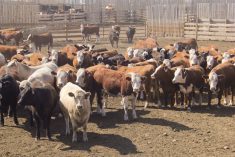Western Canadian feeder cattle prices were $1 to $3 lower on average across Western Canada. The E. coli-related beef recall, along with the temporary closure of the XL Foods plant at Brooks, Alta., has set a negative tone to fed and feeder cattle prices.
Fed cattle prices dropped to $106 per hundredweight (cwt) in Alberta last week, weighing on current feeding margins. Feedlot operators are leery and vigilant when purchasing replacement cattle. Special features that once enhanced buying enthusiasm are now considered “run of the mill” with discounts growing for lower-quality cattle.
Read Also

U.S. livestock: Feeder cattle hit contract highs on tight supply
Chicago | Reuters – All Chicago Mercantile Exchange feeder cattle futures and most live cattle futures hit contract highs on…
It takes time for the price-conscious consumer to recover from a beef scare, especially when weaker pork prices are featured on retail shelves. Wholesale beef prices continue to grind lower and packing margins are in red ink, so the industry is on the defensive, which usually results in weaker feeder prices.
Calf prices were steady to slightly lower last week; a small group of black medium flesh steers weighing just over 600 pounds sold for $148/cwt in central Alberta. Simmental steers weighing 675 lbs. were selling for $142/cwt. Yearlings were noticeably softer, with exotic heifers weighing 850 lbs. moving at $123/cwt at the same sale. A group of Charolais-cross steers averaging 740 lbs. moved at $140/cwt in southwestern Saskatchewan. Lightweight cattle under 400 lbs. continue to hold value, trading in the range of $180-$200/cwt, landed in southern Alberta.
Barley prices are quite erratic now that the combines have stopped rolling and the bins are locked up for winter. Certain feedlots outside southern Alberta are having to pay premiums to attract farmer selling. Feedlots are factoring higher prices over the winter period, which has also reduced buying interest for replacement cattle.
I expect western Canadian feeder cattle prices to remain under pressure over the next 30 days. Markets do not like demand uncertainty and some cattle feeders are holding off on purchases in the short term until this latest issue is fully resolved. Auction market volumes are running below year-ago levels and the bulk of the feeder cattle will come on the market later in fall.















